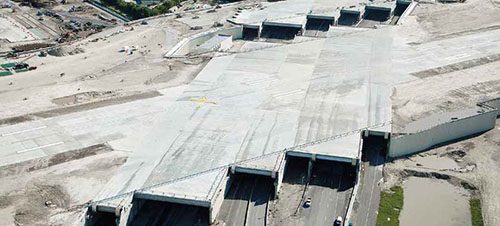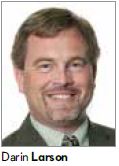 Fort Lauderdale-Hollywood International Airport (FLL) celebrated the completion of a colossal, long-range airfield initiative in mid-September. The $791 million project created South Runway 10R-28L by extending, shifting and lengthening the former 9R-27L from 5,276 feet to 8,000 feet. The new runway rises from grade-level on the west end to roughly 60 feet in the air on the east end, spanning a railway line and federal highway in between.
Fort Lauderdale-Hollywood International Airport (FLL) celebrated the completion of a colossal, long-range airfield initiative in mid-September. The $791 million project created South Runway 10R-28L by extending, shifting and lengthening the former 9R-27L from 5,276 feet to 8,000 feet. The new runway rises from grade-level on the west end to roughly 60 feet in the air on the east end, spanning a railway line and federal highway in between.
With the complex, multi-project initiative complete, the South Florida airport now has parallel runways to serve its growing traffic demands. It also has greater airfield capacity – up from 84 flights per hour to 107.
When combined with the ongoing $450 million Terminal 4 configuration, total cost of the new runway is estimated at $1.24 billion.
 factsfigures factsfiguresProject: New Runway & Airfield Reconfiguration Location: Fort Lauderdale-Hollywood (FL) Int'l Airport Owner/Operator: Broward County New South Runway: 10R-28L Est. Cost: $791 million Funding: $250 million from AIP over 12 years; $129 million from FL Dept. of Transportation over next several years; approx. $412 million from passenger facility charges Height of Runway's East End: 60 ft. above ground level Program Mgmt. Prime Consultant: AECOM-DMJM Aviation Highway/Railway Structures Prime Contractor: Tutor Perini Fort Lauderdale-Hollywood Venture (Tutor Perini Corporation & Baker Concrete Construction) Runway Construction Mgmt. Prime Consultant: Parsons Transportation Group Elastomeric Bearing Assemblies for Bridges: D.S. Brown Co. Engineer of Record for Runway/Taxiway Tunnel Structures: HNTB Corp. Associated Roadway & Life-safety Elements: HNTB Corp. Runway Lead Designer: Atkins Design Support, Drainage Design & Permitting: RS&H Pavement Design, NAVAID Siting, Erosion & Sediment Control Design, AOA Fencing Design: RS&H Dynamic Soil Compaction: Odebrecht/Central Florida Joint Venture Runway Quality Acceptance & Materials Testing: PSI Concrete: Archer Western Site Civil Work & NAVAID Infrastructure Construction: Odebrecht-CFE Airfield Lighting, Wind Cones, Constant Current Regulators, PAPIs, Halogen Signs: ADB Airfield Solutions Engineered Material Arresting System: Zodiac Arresting Systems |
Broward County Aviation Department, the entity that owns and operates FLL, funded the recently completed runway project through a Letter of Intent from the FAA to provide $250 million in Airport Improvement Program funding over 12 years; Florida Department of Transportation will contribute a total of $129 million over the next several years. Remaining costs, roughly $412 million, will be paid for by passenger facility charges.
In addition to alleviating airfield capacity constraints, the addition of a second, parallel commercial runway was engineered to reduce the potential for runway incursions and simplify ground movement of aircraft. The former airfield configuration made maintenance on the primary runway difficult and disruptive to operations, note airport officials.
FLL previously had an imbalance between its terminal and airfield capacities, explains Doug Webster, IAP, deputy director of the Broward County Aviation Department. "The intent of the South Runway Project was really to meet the natural demand that was happening in the marketplace," says Webster. Currently, the airport services about 23.5 million passengers per year. Of those, via roughly 2.5 million are international passengers. Annual operations number 270,000.
Before the recent runway addition and airfield reconfiguration, all air carrier traffic, except for some very light commuter service, was limited to the North runway – a factor that contributed to flight delays. "Even though we had three runways, they really weren't functional to meet the demand of the airport," Webster explains.
Decades of Planning & Prep
The need to expand airfield capacity was identified in the mid '90s, when the airport was updating its Master Plan, Webster recalls. As FLL's traffic grew, delays increased as well. And the delays not only impacted the southern Florida airport, but ultimately the entire U.S. air system as well, says Steven T. Wiesner, P.E., assistant director of aviation-airport development.
Broward County Aviation Department began acquiring land for the runway expansion (about 60 acres) in the '90s. More recently, it demolished a parking garage, Hilton hotel, and building that previously housed Dania Boat Sales to create room for a runway protection zone.
Webster recalls one point during the planning phase when the Environmental Impact Study process identified nine different possible plans – including a "do nothing" option. "It was an exhaustive study," he notes.
From a geographic standpoint, the airport is essentially landlocked. With an interstate to the north and west, residents to the south, and a railroad and federal highway to the east, creative thinking and planning were key to addressing the airport's airfield needs, Webster explains.
The railroad tracks had already been moved once in the late '80s to accommodate the lengthening of Runway 9R-27L. "There wasn't going to be a whole lot more you could do from an option standpoint," he relates. "You had to find a way to get over it (the railroad track); or else this project wasn't going to happen."

Strange as it sounds, building the new runway over a federal highway and railroad tracks was determined to be the "easiest obstacle to overcome."
The associated list of project stakeholders, however, was very long: multiple airlines, FAA, Florida Department of Transportation, Florida East Coast Railroad, Broward County Board of Commissioners and more. Surrounding residents were also a crucial faction. The project's $250 million noise mitigation program includes $115 million for 1,800 homes that are candidates for sound insulation.
Preparing for Construction
Design for the runway was divided into two projects. The bridge structure was handled as a design-build contract, with HNTB serving as designer of record. Atkins was lead designer for the runway project and was responsible for the design criteria package for the bridge structures.
Prior to the project, FLL had three runways – a 9,000-foot runway on the north side, a 5,200-foot on the south side (which became the new runway) and a 6,900-foot crosswind runway that bisected both. Due to the location of the new runway's elevation point, the crosswind runway was closed permanently. That meant FLL operated with only one runway from May 2013 until recently, when the new runway opened.

"We were effectively the busiest single runway airport in the country," Webster notes. The FAA performed an "intense amount" of planning to prepare for the project, and developed a "very comprehensive game plan" to manage traffic during the construction period, he adds.
Delays were simply inevitable. While Wiesner acknowledges that some delays were "significant" – with airplanes on the ground for up to 35 minutes during the peak of winter – he also notes that on the whole, they were much shorter than originally anticipated. "We beat all expectations relative to the original forecast of what was anticipated from a delay standpoint," he reports. "FAA did an outstanding job of managing traffic."
Prior to closing the crosswind runway, the airport constructed Taxiway C, a parallel taxiway to Taxiway B on the north side of the airfield, Webster adds.
An FAA navigation aid, ASR-9, also had to be relocated prior to runway construction. In roughly two years, FLL and FAA found a new site, designed and constructed the new ASR-9 and brought it online before the old one was taken out of service, Wiesner explains.
Sorry Soil Conditions
In addition to space constraints, the runway expansion team also faced poor soil quality on the east end of the airfield. Because all of South Florida was once part of the Everglades, most of the airport's land includes fill. Project sites require significant preparation to create effective building surfaces.

The original project design, which called for removing poor soil and relocating it to a landfill, was found to be too costly, Wiesner recalls. Instead, several different soil improvement techniques were employed around the airfield. In some places, contractors brought in fill and topped it with a surcharge for about nine months to help it settle. During that time, the team performed regular surveys and readings to track the rate of settlement. Once it displayed an imperceptible amount of settlement, the surcharge was removed and the project moved forward.
On the west end of the runway site, crews encountered occasional voids in the cavity of the subsurface. Once a cavity comes to the surface, it becomes a sinkhole, explains Webster. To prevent that, crews used dynamic compaction, a process that uses heavy weights to compact the voids.
The contractor also introduced some different methods for ground improvement than were originally specified in the design – a dynamic Atkins officials attribute to close collaboration among team members. One such method was mammoth vibratory tamper, a process designed to yield the same result as deep dynamic compaction that was found to be more appropriate for certain areas of the project, explains Darin Larson, P.E., LEED AP, vice president with Atkins.
The different soil improvement techniques used throughout the site were carefully evaluated, says Larson: "We had to weigh the cost of doing the different techniques with the schedule impacts against the overall goal of getting the runway opened."

In total, about 6 million cubic yards of soil was needed for the runway project; and getting it to the airport in a short period of time proved to be a challenge. Because FLL is located in a congested, urban area, trucking in fill material was not an ideal option – from a cost or environmental standpoint, notes Larson. To solve this problem, the airport built a spur off of the railroad that the new runway crosses. Although some fill was trucked in, a large portion arrived by rail. For about nine months, two loads of fill material arrived on railroad cars, six days per week. At times, the contractor was applying up to 22,000 cubic yards of fill per day, reports Wiesner.
To overcome soil challenges for the bridge structure, the team used a series of stone columns around the embankment portions. Crews drilled a 2- to 3-foot diameter hole into the ground 20 to 30 feet deep, then poured in a dense gravel mixture that was vibrated into place. As the weight of the new embankment was pressed down, the load was transferred around the weaker soils and into solid ground, explains Scott Dean, P.E., associate vice president at HNTB.
Soil conditions even affected the team's ability to maintain traffic on the federal highway, another important aspect of the project, notes Larson. As two large bridge structures were built over the top of it, workers had to "maintain a reasonable amount of traffic flow through there on a daily basis," he explains.
Working in carefully orchestrated phases, the team started by shifting the roadway itself to the east of the area where the structures were being built, Larson chronicles. At that point, the goal was to get the structures complete enough so traffic could be shifted back into one of the cells of the two bridge structures to allow for completion of the embankment on the east side, because it left a wedge-shaped area to the east of those structures that needed to be filled with roughly 40 feet of embankment material. Additionally, that material needed time to settle before it could be paved upon.
The sequencing of traffic movement and settling time for embankment material became a critical element in the project, Larson recalls. Unfortunately, it was also a very open-ended issue. "You never knew how long it was going to take for that embankment to settle," he notes.
Settlement plates were placed on the embankment to accelerate the process, and progress was measured frequently. "Knowing when we could start paving was literally a week-to-week point of evaluation," says Larson.
Bridging the Gap
HNTB was subcontracted under Tutor Perini in a design-build agreement for the series of structures that allow the runway and parallel taxiway to cross over U.S. Highway 1, the airport entrance and service roads, and the Florida East Coast railroad tracks without interruption.
The multi-span bridge HNTB created is actually classified as a tunnel, due to the length that the traveling public must drive while underneath, Dean explains. As a result, HNTB's designs had to incorporate a full life-safety system, including lighting, fire suppression and smoke evacuation. FLL developed a unique partnership with the Florida Department of Transportation to operate the life-safety systems and maintain the roadway under the runway and taxiway, Wiesner notes.
The bridge structure used standard roadway bridge beams that were "significantly strengthened" to sustain the weight of a fully loaded 747 aircraft, Dean reports. "While we utilized a standard highway bridge beam type construction, because the loading on the bridge is more robust, the beams are thicker, heavier and denser," he explains.
In total, bridge structures accounted for $178 million of the total $791 million project cost.
Accommodating Int'l Growth
While good overall, the growth FLL has experienced in international markets over the last few years also proved to be complicating a factor during the runway project. In the first quarter of 2014 alone, FLL's international activity grew by 33%. Additionally, its ranking with Customs & Border Protection recently moved from the 20th to 15th busiest.
"It's made it extremely complicated and required extensive coordination and cooperation with air carriers," Webster says.
To accommodate the growing traffic, FLL often receives international flights at international gates but relocates aircraft to domestic gates as soon as passengers are unloaded.
With the runway project in full swing, Wiesner joked that there was little left at FLL that resembled an airport. "It really looks like a construction site with an airport trying to operate in the middle of it," he said, emphasizing the importance of working closely with the carriers.
"They can sometimes bring solutions to the table also," he noted. "It's really a dynamic scenario, with everyone trying to work together."
|
By the Numbers
The recently completed south runway project at Fort Lauderdale-Hollywood International Airport required a mammoth amount of materials: Fill: 7 million cubic yards |


